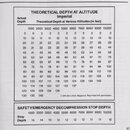TinFins
Contributor
Hi All,
I have some dive physics questions about Lake Tahoe. I have read a lot about altitude diving, I've even had a short course, but there are a couple questions I guess I just am not smart enough to clear up on my own.
1. My computer (Oceanic Atom 3.1) read 94 feet as my depth yesterday in Lake Tahoe. I understand that this is not the actual depth, but the equivalent amount of pressure to 94 feet of seawater at sea level.
-What was my actual depth?
2. When you ascend, 15 feet in Lake Tahoe is similar to +-15 feet in Monterey, but when you reach the surface you are suddenly at 6300' elevation.
-How is this different than diving Monterey and upon surfacing, getting in a helicopter and instantly flying up to 6300'?
Thanks in advance!
I have some dive physics questions about Lake Tahoe. I have read a lot about altitude diving, I've even had a short course, but there are a couple questions I guess I just am not smart enough to clear up on my own.
1. My computer (Oceanic Atom 3.1) read 94 feet as my depth yesterday in Lake Tahoe. I understand that this is not the actual depth, but the equivalent amount of pressure to 94 feet of seawater at sea level.
-What was my actual depth?
2. When you ascend, 15 feet in Lake Tahoe is similar to +-15 feet in Monterey, but when you reach the surface you are suddenly at 6300' elevation.
-How is this different than diving Monterey and upon surfacing, getting in a helicopter and instantly flying up to 6300'?
Thanks in advance!





